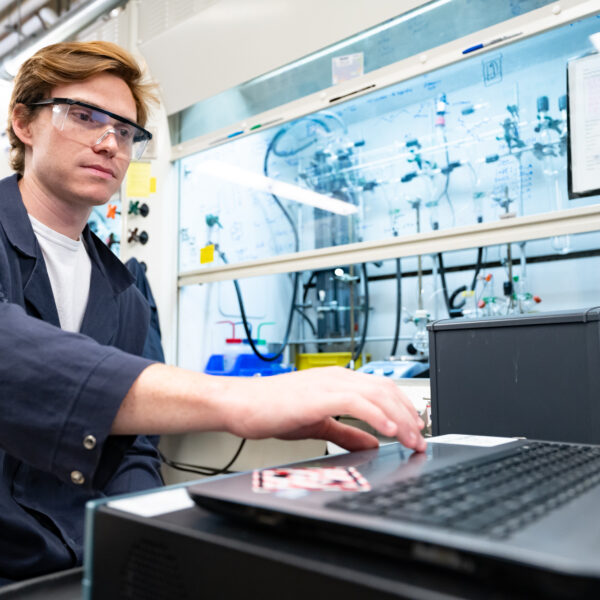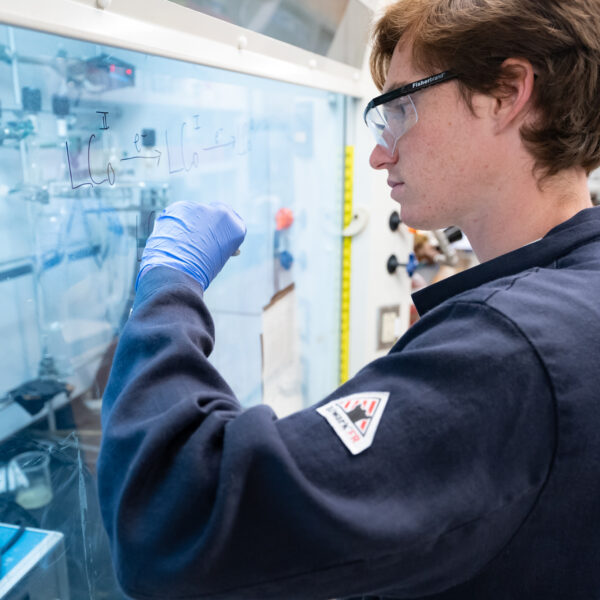Chemical bonds that can lead society to carbon neutrality
Hello everyone, my name is Adam Samuel, and I am beginning my fourth year as a Ph.D. candidate working in the research lab of Professor Smaranda Marinescu as a part of the Department of Chemistry at the University of Southern California. During my work I have studied molecular electrocatalysis for the reduction of CO2 to value added products that can be used as fuels. I am lucky enough to have been selected as a Wrigley Graduate Fellow this summer.

Global infrastructures have been heavily reliant on carbon-based fuels since the dawn of the industrial revolution in the 19th century. However, a consequence has been a large influx of CO2 emissions into the atmosphere, which has been the primary contributor to climate change: resulting in global warming, disastrous wildfires, polar ice cap melting, and ocean acidification. As well as the environmental concerns associated with carbon-based emissions, the fuels they are liberated from are limited. A recent approach of the last few decades is to turn to renewable resources as a means to power society. Natural energy sources such as solar, wind, and hydro are favorable because they do not emit greenhouse gases into the atmosphere nor do they have the issue of radioactive waste, associated with nuclear energy.
Unfortunately, renewables are transient, and it is not practical for us to only generate electricity when it is windy or when it is sunny. A current approach is to store this energy to be used later, but current battery technology is unable to effectively store the energy from these transient sources. The approach I take in my research is that I use electricity to power my chemistry so that I can store energy in the form of chemical bonds. Using electricity, potentially from renewables, I can perform electrocatalysis to reduce CO2 to value added products, which would close the CO2 cycle, and make society carbon neutral. This is an alternative approach because CO2 can be transformed into energy dense materials that can be simply stored as chemicals and used at any time, eliminating the transient problem associated with renewables. Similarly, the use of electricity rather than heat and pressure to drive the reaction is attractive in industry because of the problems associated with the latter.

I study an organometallic catalyst (a metal with a carbon scaffold surrounding it) for the electrocatalytic reduction of CO2. It is no secret that CO2 is the biggest contributor to climate change as the most abundant green house gas in the atmosphere, but it also very difficult to activate chemically. My approach is to find useful ways to activate this relatively inert molecule. The CO2 molecule is a three-atom linear molecule with the carbon as the center piece. Atoms have different affinities for electrons and as a result when different atoms are bound to each other there is an unequal sharing of electrons resulting in a shift of electron density which is responsible for a large majority of chemical reactions. In regard to CO2 the terminal oxygens of the molecule pull electron density from the center carbon making it electron deficient, or what is called Lewis acidic. The carbon is the point of “attack” for my electrocatalyst which propagates the transformation of CO2. Although more than just my catalyst is needed to successfully transform the invasive gaseous molecule.

Anytime CO2 is transformed an acid (proton source) is used in tandem with the catalyst to help the transformation. My project is looking at the effects of proton sources and how they influence the transformation of CO2. This could potentially influence the products that CO2 is transformed into. Currently there is no fully acknowledged mechanism for electrocatalytic CO2 reduction, and if the scientific community were to understand what exactly takes place during this transformation it would usher in a revolution of CO2 electrocatalysis. So, as well as trying to selectively make an array of different products from CO2 I also aim to understand the mechanism by which it happens. With a clear understanding of how the reaction happens, it becomes clear what structural motifs of the molecule are aiding in this reaction. This information can be used to create second generation catalyst technologies that can have larger practical applications outside of academic laboratories.

Currently in my studies I have observed the reduction of CO2 to CO (the most commonplace product in electrocatalysis) and am testing my samples to see if my made other carbon-based products such as methanol or formate. Surprisingly, I have never observed appreciable hydrogen evolution while conducting my experiments. This is important because hydrogen evolution is a common unwanted side reaction. As I continue my studies, I am excited to explore the applicability of my catalyst and what new transformations of CO2 I can unlock.
I would like to thank the Wrigley Institute for their support of my research this past summer!
